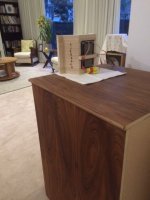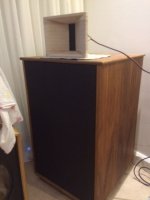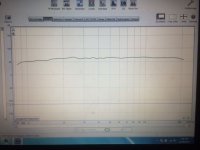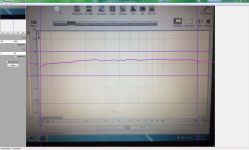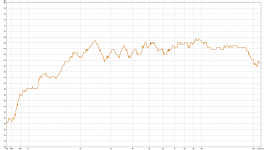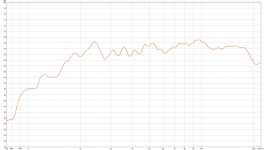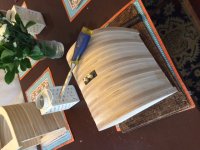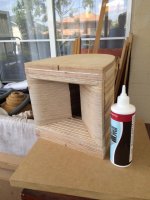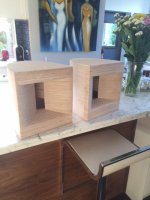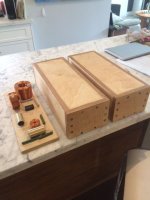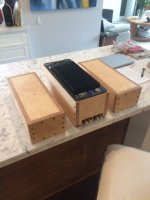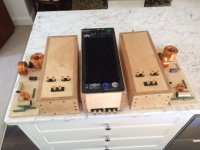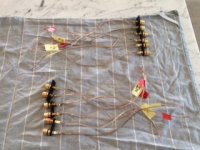Tonight I hooked up the Beyma TPL150's into my CNC'd horns...lovely sound, smooth, lots of sizzle. Crossed a little low at 1,400Hz...maybe 1,800Hz better.
The Altec 420A is running 'full range'....no low pass.
Lovely sound stage, big.
The tweeters really excel....triangles, cymbals really nice.
The Altec 420A is running 'full range'....no low pass.
Lovely sound stage, big.
The tweeters really excel....triangles, cymbals really nice.
Attachments
Tonight I hooked up the Beyma TPL150's into my CNC'd horns...lovely sound, smooth, lots of sizzle. Crossed a little low at 1,400Hz...maybe 1,800Hz better.
The Altec 420A is running 'full range'....no low pass.
Lovely sound stage, big.
The tweeters really excel....triangles, cymbals really nice.
That's great. Looking forward to reading your comments when you replace the factory back chamber in the TPLs with the much larger space you built with the wood enclosure.
BTW, the yellow caps in the back are for protection only? What values are you using? I guess I should do the same.
Tonight I hooked up the Beyma TPL150's into my CNC'd horns...lovely sound, smooth, lots of sizzle. Crossed a little low at 1,400Hz...maybe 1,800Hz better.
The Altec 420A is running 'full range'....no low pass.
Lovely sound stage, big.
The tweeters really excel....triangles, cymbals really nice.
I can't imagine why you would want to run the 420's full range. In doing so, you will have a confused/diffuse imaging to where using something as refined as the Beyma tweeter is a waste. With respect to the performance of the Altec 420, much better results can be achieved if you limit the deep bass feed into it. Otherwise, you will have created a situation where the mid range frequencies ride upon the excursions required for bass. This is known as modulation distortion, which is the single most offensive distortion of all.
Please note I did state "deep bass". Keeping most of the voice fundamentals intact from one single source such as the Altec 420, should result in very, very good sound quality.
Scott, thanks for the thoughtful feedback. Running the 420A full range is strictly temporary only. I'll build a suitable xover later, including some high pass for the lowest freq. A test on the driver in box last night showed it is flat to 30Hz, then drops quickly from there. What would your suggestion be re the low end?
Here's a measurement of the tweeter, with sweep from 800Hz to 20,000, 1/12th smoothing. I'm happy with the result. I'm keen to test it at a higher xover point, eg 2,000Hz.
Looking smooth, although the vertical scale is way too large to tell much. Can you show for example 5 dB above max attained by the tweeter and down to -10 or -15 from average tweeter response?
Looking smooth, although the vertical scale is way too large to tell much. Can you show for example 5 dB above max attained by the tweeter and down to -10 or -15 from average tweeter response?
Agreed, also appears to be on the 65-75db range? Would be better to see something closer to 80-85db, and a scale in the 60-90db range, that will give you much more resolution. And definitely no need for a negative scale.
Great build, subscribed!
Javad
🙂 50dB scale into REW when photo-plot is traced with FPGraphTracer : fprawn labs.
Picture one is the tracing act to show there will be some small distortion taking place because camera is little angled verse LCD screen when photo is shut.
Picture two is frd-file imported into REW and no smoothing.
Picture three is frd-file imported into REW and 1/24 smoothing.
Picture one is the tracing act to show there will be some small distortion taking place because camera is little angled verse LCD screen when photo is shut.
Picture two is frd-file imported into REW and no smoothing.
Picture three is frd-file imported into REW and 1/24 smoothing.
Attachments
Last edited:
Looking very nice! And I'm really sorry for you that you couldn't make further progress because you were stuck in Bali. Tough life! 🙂
BTW, I've been doing some reading towards protecting my TPLs from low frequencies and DC in the context of an eventual malfunction of the active xo, and/or DC burst at amp turn on. Doing the math, I suspect your 18uF cap won't operate as you expect:
I think you ran the numbers assuming it was an 8 ohm load:
F=1/(2 x pi x 18uF x 8 ohm) = 1105 Hz
But the TPL is a 4.9 ohm load, so rerunning the math I end up with a corner frequency of 1800 Hz, which I understand is too close to the actual xo frequency.
From the same reading I've been doing I came across a recommendation from the guy behind DEQX saying a good rule of thumb for tweeter protection caps in an active system is to use a corner frequency two octaves below the intended xo.
Please take it as constructive feedback! And if I'm missing something please explain so I can learn. I'm coming up with a protection cap of 65uF, which is expensive for protection only...😱
BTW, I've been doing some reading towards protecting my TPLs from low frequencies and DC in the context of an eventual malfunction of the active xo, and/or DC burst at amp turn on. Doing the math, I suspect your 18uF cap won't operate as you expect:
Lewinski, yes, about 18uF, giving theoretical first order xover @ 1,100Hz, 8ohm.
I think you ran the numbers assuming it was an 8 ohm load:
F=1/(2 x pi x 18uF x 8 ohm) = 1105 Hz
But the TPL is a 4.9 ohm load, so rerunning the math I end up with a corner frequency of 1800 Hz, which I understand is too close to the actual xo frequency.
From the same reading I've been doing I came across a recommendation from the guy behind DEQX saying a good rule of thumb for tweeter protection caps in an active system is to use a corner frequency two octaves below the intended xo.
Please take it as constructive feedback! And if I'm missing something please explain so I can learn. I'm coming up with a protection cap of 65uF, which is expensive for protection only...😱
Lew, thanks for your thoughtful reply.
My comment earlier was for tempory use only. I have high class LR2 Xovers built for the mid and tweeter.
Andrew.
My comment earlier was for tempory use only. I have high class LR2 Xovers built for the mid and tweeter.
Andrew.
Joro, thank you for your kind remark. It's funny, I've had no training in wood work...no trade background. I'm a senior exec for a large charity, sitting behind a desk Monday to Friday. Yet, I can 'see' the final product in my mind...and I keep going until I get there. A lot of my work takes trial and error...but that is how I've learnt about the tools. Also, I use CAD/CNC where possible. My 'workshop' at home consists of the car port and kitchen. I use cheap tools from Bunnings hardware...but luckily have access to a local Men's Shed (Dural Baptist Church) which has large table saws, sanders, etc.
My dream is to semi-retire and have a few days per week building cabinets and nice furniture in my own workshop.
Andrew
My dream is to semi-retire and have a few days per week building cabinets and nice furniture in my own workshop.
Andrew

Off topic posts and comments removed by moderation. Stick to the topic and take your personal stuff over to email.
Looking great.
Have you established your final xo points and slopes yet?
Thanks.
1,65Hz, LR2
Bass to be decided soon...likely around 175/200.
- Status
- Not open for further replies.
- Home
- Loudspeakers
- Multi-Way
- New 3-way, 18 inch bass, Beyma TPL150 AMT Horn
